Pivot
Pivot tables are one of the most useful widgets for visualizing data. They enable you to quickly summarize and analyze large amounts of data.
Adding Data to a Pivot Table
Select the data to appear in the Pivot.
-
In the Rows panel, click Add + to select the field(s) whose values will be placed in the rows of the Pivot table.
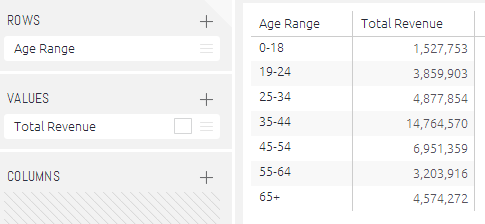
Note:
When Sisense is deployed on Linux, you can display HTML in your Pivot 2 cells as HTML or plain text. To select Admin > System Management, and then under the Pivot area toggle the switch Allow rendering Pivot Table content as HTML. When the switch is enabled, Sisense renders HTML as HTML, and when it's disabled, Sisense renders HTML as plain text.
When more than one Row is selected, the Rows are broken into sub-rows (groups). For example, the following shows Condition added as a second Row:

-
In the Columns panel, click Add + to select the field(s) whose values will be placed in the columns of the Pivot table.
You can drag and drop the fields that you added to Columns to the Rows area and vice versa.
-
(Pivot1 only) In the Values panel, select a field whose values will appear in the Rows and Columns of the Pivot table.
Tip:
Right-click the value to add data bars to your pivot table.

Grand Totals and Subtotals
You can add Grand Totals and Subtotals to your tables, and define how to calculate Subtotals.
To add Grand Totals and Subtotals to rows:
-
Click on the menu of the Row in the Data Panel, or right-click on the row header in the widget, and select Grand Totals or Subtotals.
Note:
Subtotals are enabled only if you have more than one row in your table.

-
If you selected to display Subtotals, select the method by which to calculate them. Click the menu of the Value in the data panel, and then click Subtotal by and select the method.
Note:
You can choose different Subtotals in each field. To do this, click the header of the desired value in the table, click Subtotal By and select the method.
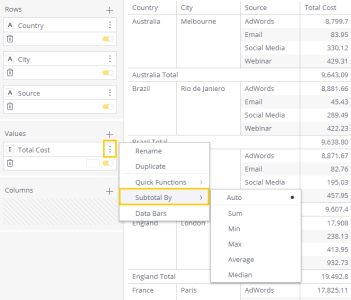
The default option is Auto, which aggregates all the data, sending a separate query to the data model. This means that Sisense applies the same formula set in the measure to the entire data. The other custom options (Sum, Min, Max, etc.) calculate only the values in the rows above the Subtotal, based on the data presented in the Pivot table, in place of the original formula set in the measure..
Consider the following:

In the top example, using the Auto option, the Subtotal for average revenue aggregates all the sales and revenue data. This represents a true Subtotal of the average revenue for the Asia region.
In the bottom example, Average is used to calculate the Subtotal, and therefore calculates the average of all the average revenue values in the rows above the Subtotal.
Grand Totals
Grand totals aggregate the rows in the pivot table.
To add grand totals:
-
Click on the menu of the row in the data panel, or right-click on the row header in the widget, and then click Grand total.
If defined, the Grand Totals is affected by Subtotals. In the following example, the Grand Total for Average Sales is 10, representing the average sales for two regions (Asia and Europe). In the example below, Average Sales has a Subtotal (see above) set to Sum, and therefore the Grand total is the total of the rows above.

Rectifying Problems with Grand Totals and Subtotals
In some cases, it may seem that the grand or Subtotal are calculated incorrectly. The reason may be just the selected calculation method.
In other cases, you may to calculate weighted averages in the Grand and Subtotals instead of the arithmetic mean that is used by the system.
To rectify problems with Grand Totals and Subtotals:
-
Change the Subtotal By from Auto to Average :
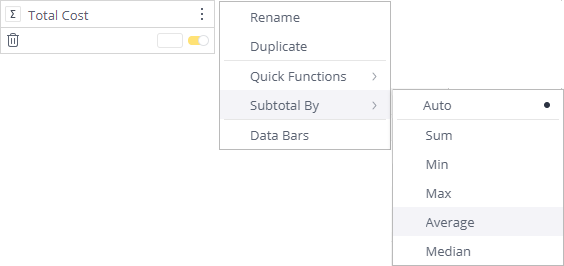
To calculate weighted averages in the grand and Subtotals:
-
The Subtotal by average takes the values in the rows above it, therefore cannot be set to show a weighted (multi-pass) average. A way to achieve this is to change your formula in a way that when Subtotals are set to Auto, it will show the weighted average.
For example, see the below use case (from the Sample Healthcare dashboard), using weighted aggregation:
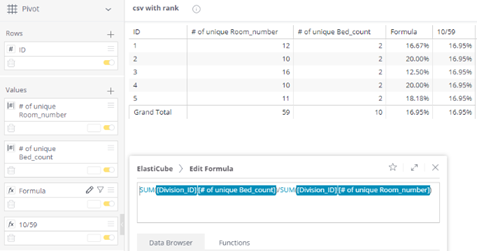
Two connected fields are used here: division.ID and Rooms.Division_ID. The two fields are used from the dimension table in 'Rows' and its equivalent in the fact table in the formula.
In this example, we count beds per division, sum the results, and divide this result by the sum of rooms per division. When looking at a specific division, it is the same as counting beds/rooms, but as a total, it is 10/59 (sum/sum) - the weighted average.
For a more detailed example, see here .
Designing the Pivot Table
Fine-tune the appearance of the PIVOT table, using the following tools.
- Page Size : Specify how many rows appear in each page. Paging options are provided accordingly. The maximum number of rows per page is 200 rows.
-
Colors : Select the shading properties for the Pivot table's row and column elements.
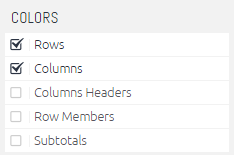
Exception Highlighting
Conditional formatting can be used for exception highlighting in a Pivot table. For example, as shown below:
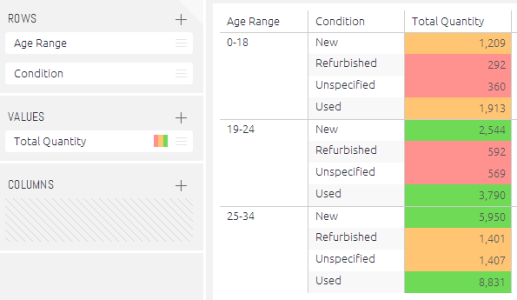
Sorting Pivot Tables
You can sort pivot tables:
- by rows alphabetically
- by values numerically
Sorting pivot tables by multiple values enables flexibility for displaying data.
Sorting by values only applies to the last level of granularity. That is, sorting is applied to the groups within the last row.1_600x568.png)
Sorting Alphabetically
Pivot table rows can be sorted alphabetically in ascending or descending order by clicking the sort icon (![]() ). The following uses Example_Pivot_Table as the example, where Country is sorted in descending order.
). The following uses Example_Pivot_Table as the example, where Country is sorted in descending order.
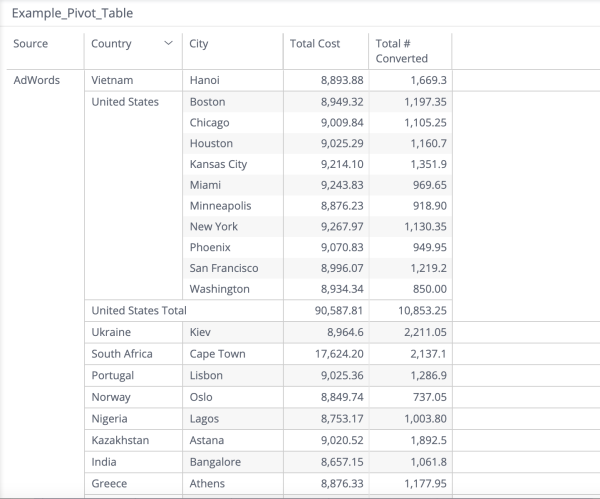
Sorting by Values
Another option is sorting according to a column’s values. Sorting by values only affects the last column before the values.
Using Example_Pivot_Table as the example, if you wanted to sort ‘City’ grouping by the ‘Total Cost’ values, in the ‘Total Cost’ column, click the sort icon (![]() ) to determine whether it will be an ascending or descending sort.
) to determine whether it will be an ascending or descending sort.
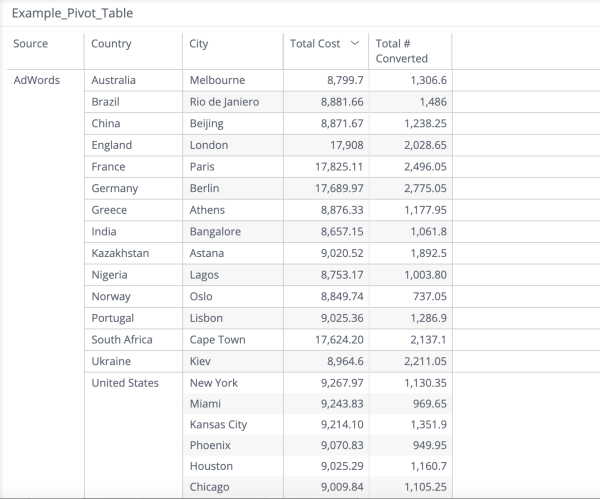
Limitations
- Sisense supports the exporting of pivot tables of up to 1.5 million cells. Attempting to export a higher number of cells might result in a timeout. The following properties of a pivot table increase the probability of reaching a timeout when dealing with very large tables:
- Sub totals or Grand totals
- Complex formulas in Values
- Data Security rules
- Widget-level filters
To successfully export pivot tables, split large pivot table with many columns to separate smaller pivot tables.
- The maximum number of rows per page is 200 rows
.r.